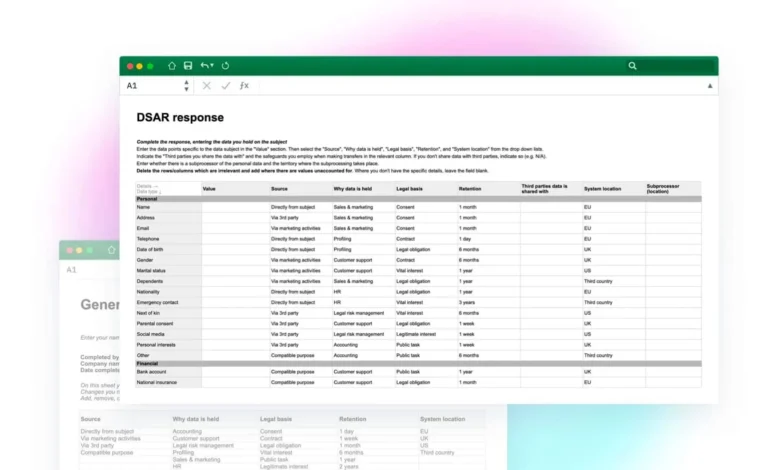DSAR Template – Free Data Subject Access Request Form (GDPR Compliant)

In the age of digital information, personal data has become one of the most valuable assets in the world. With this comes a growing need for transparency and accountability in how that data is used, stored, and shared. A Data Subject Access Request (DSAR) allows individuals to exercise their right to access personal data held by organizations under the General Data Protection Regulation (GDPR). For businesses, creating a structured and compliant DSAR template is an essential part of meeting their legal and ethical obligations.
A DSAR template serves as a standardized form or document that helps organizations efficiently handle data requests from individuals. It ensures consistency, reduces the risk of errors, and streamlines internal processes for responding within the legal timeframe. Whether you’re a multinational company or a small business owner, using a DSAR template can simplify the complex process of data disclosure while demonstrating your commitment to privacy compliance.
In this comprehensive guide, we’ll break down everything you need to know about DSAR templates—from what they are and why they matter to how to build, use, and maintain one effectively. By the end, you’ll have a clear understanding of how to stay GDPR-compliant while respecting your customers’ privacy rights.
Understanding DSARs (Data Subject Access Requests)
A Data Subject Access Request (DSAR) is a formal request made by an individual to a business or organization asking to see what personal data is being collected and how it is processed. Under Article 15 of the GDPR, every person within the EU and UK has the right to know what data a company holds about them and why. This right extends to copies of personal data, processing purposes, data sharing, and data retention policies.
The importance of DSARs cannot be overstated. They empower individuals to take control of their personal information and ensure that organizations are transparent and accountable in their data handling practices. For businesses, responding properly to a DSAR not only avoids potential fines but also strengthens consumer trust—a critical advantage in today’s privacy-conscious market.
Legally, organizations must respond to a DSAR within one month of receiving it. Extensions may apply for complex cases, but companies must always communicate delays clearly. Failure to comply can result in significant penalties under the GDPR, sometimes amounting to millions of euros. Having a ready-to-use DSAR template helps prevent such risks by ensuring your team follows a clear, documented, and compliant procedure every time a request is made.
The Essential Components of a DSAR Template
A well-designed DSAR template must capture all the key information required for both the requester and the organization to process the request efficiently. The first section typically includes basic personal information—such as the requester’s name, email address, and contact details. This ensures that the company can correctly identify the individual making the request. Verification of identity is crucial to prevent unauthorized access to someone else’s data, and the template should clearly outline acceptable forms of ID.
Next, the DSAR template should have a data description section, where the requester specifies the data they want access to or the systems they believe hold their information. This helps narrow the scope and speeds up processing. Including your organization’s contact details and the name of your Data Protection Officer (DPO) within the template is also essential for transparency.
Lastly, the DSAR template should contain a privacy and consent statement, explaining how the information provided in the request will be used—strictly for fulfilling the DSAR—and how long it will be retained. Including a timeframe acknowledgment (usually 30 days) and outlining any exceptions or fees ensures both parties understand their rights and responsibilities. A clear, structured DSAR form not only protects your organization legally but also provides a professional and trustworthy experience for the requester.
How to Use and Manage a DSAR Template
Implementing a DSAR template is only the first step—managing requests properly is where true compliance begins. The process usually starts with acknowledging receipt of the request. Your organization should confirm that it has received the DSAR and inform the individual about the next steps. Once the identity of the requester is verified, the data collection phase begins. This involves searching across all databases, email archives, cloud systems, and third-party processors for any data related to the requester.
Responding to DSARs can be time-consuming, especially for large organizations with complex data structures. Common challenges include incomplete requests, overlapping data sources, and the need to redact third-party information. Using digital tools or DSAR automation software like OneTrust or TrustArc can significantly streamline this process. These platforms integrate with your existing systems, automatically locate data, and generate standardized response documents.
Another key aspect of DSAR management is documentation. Every DSAR request should be logged with details like submission date, assigned handler, and response outcome. This audit trail proves compliance during data protection audits or investigations. Finally, ensure that your DSAR responses are sent securely—using encryption or password-protected files—to safeguard sensitive information during transmission. Following these steps helps your organization maintain compliance, efficiency, and public trust.
Best Practices for DSAR Compliance

To stay compliant and avoid data mishandling, organizations should develop a DSAR policy outlining how requests are received, processed, and completed. Training employees on DSAR procedures is equally critical. Every staff member who handles personal data should understand their role in maintaining compliance, from verifying identities to securely transferring data.
Maintaining data security is another essential practice. All personal data shared during a DSAR response must be encrypted and sent through secure channels. Sensitive information about third parties should be redacted before disclosure. Regular internal audits ensure that your DSAR template and policies remain up to date and effective.
Lastly, your DSAR template should evolve alongside regulatory changes. As privacy laws expand globally—like the UK GDPR, EU GDPR, and CCPA (California Consumer Privacy Act)—companies must adapt their forms and processes accordingly. Updating your DSAR template annually ensures continued compliance and reflects your organization’s ongoing commitment to privacy protection.
Sample DSAR Template (Editable Format)
A simple DSAR template might include the following structure:
Section 1: Personal Information
- Full Name: ___________________________
- Email Address: ________________________
- Contact Number: _______________________
Section 2: Request Details
- Please describe the data or systems your request relates to:
Section 3: Identity Verification
- Please attach a copy of photo ID or utility bill to verify your identity.
Section 4: Acknowledgment
- I understand that this information will be used solely for processing my DSAR request and that I will receive a response within 30 days.
Including this kind of clear, standardized structure helps businesses handle DSARs efficiently and ensures individuals feel respected and informed throughout the process.
Conclusion
Creating and maintaining a DSAR template is more than a legal requirement—it’s a reflection of your organization’s integrity and respect for privacy. By providing individuals with clear and accessible ways to request their data, you demonstrate transparency, accountability, and a genuine commitment to ethical data management.
In an era where consumers are increasingly aware of their digital rights, taking proactive steps toward GDPR compliance builds trust and strengthens your brand reputation. A strong DSAR process, backed by a professional and adaptable template, ensures that your business not only meets legal obligations but also leads the way in responsible data handling.
FAQs About DSAR Templates
What is a DSAR template used for?
A DSAR template is a standardized form used by organizations to process data access requests from individuals efficiently and in compliance with GDPR.
How long do I have to respond to a DSAR?
Organizations must respond within 30 days of receiving the request, though extensions can be applied in complex cases.
Can an organization refuse a DSAR?
Yes, if a request is excessive, unfounded, or repetitive. However, the organization must justify and communicate the refusal clearly.
Should individuals use a DSAR template when making a request?
Yes. Using a template helps individuals structure their request clearly and ensures they provide all necessary information for a faster response.
What happens if a business fails to comply with a DSAR?
Failure to comply can result in hefty GDPR fines, reputational damage, and potential legal action.
You May Also Read: Ads Perth



